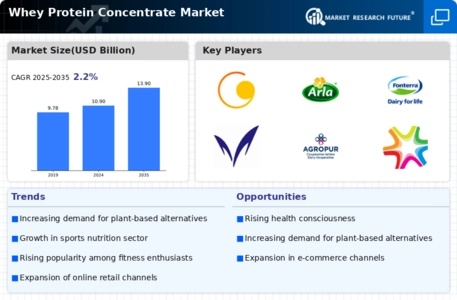Growth of E-commerce Platforms
The Whey Protein Concentrate Market is witnessing a transformation due to the rapid expansion of e-commerce platforms. Online retailing has become a preferred shopping method for many consumers, particularly for health and wellness products. This shift is evidenced by a significant increase in online sales of whey protein concentrate, which has been reported to account for over 30% of total sales in recent years. E-commerce provides consumers with easy access to a variety of products, enabling them to compare prices and read reviews before making a purchase. As more consumers turn to online shopping for their nutritional needs, the Whey Protein Concentrate Market is poised for further growth, with companies investing in digital marketing strategies to capture this expanding market segment.
Expansion of Functional Foods Market
The Whey Protein Concentrate Market is closely linked to the expansion of the functional foods market. As consumers increasingly seek foods that offer health benefits beyond basic nutrition, whey protein concentrate is being integrated into various functional food products. This trend is reflected in the growing number of protein-enriched snacks, beverages, and meal replacements that feature whey protein as a key ingredient. Market analysis suggests that the functional foods sector is expected to grow at a rate of 7% annually, which will likely bolster the demand for whey protein concentrate. This integration not only enhances the nutritional profile of these products but also positions the Whey Protein Concentrate Market favorably within the broader health and wellness landscape.
Increasing Demand for Sports Nutrition
The Whey Protein Concentrate Market is experiencing a notable surge in demand driven by the growing interest in sports nutrition. Athletes and fitness enthusiasts are increasingly incorporating whey protein concentrate into their diets to enhance muscle recovery and performance. According to recent data, the sports nutrition segment is projected to grow at a compound annual growth rate of approximately 8% over the next five years. This trend is further fueled by the rising number of fitness centers and health clubs, which are promoting protein supplementation as part of a balanced diet. As consumers become more aware of the benefits of protein intake, the Whey Protein Concentrate Market is likely to see sustained growth, with manufacturers innovating to meet the diverse needs of this expanding consumer base.
Rising Popularity of Plant-Based Diets
The Whey Protein Concentrate Market is also influenced by the rising popularity of plant-based diets. While whey protein is derived from milk, the increasing number of consumers adopting vegetarian and vegan lifestyles has prompted manufacturers to explore plant-based protein alternatives. However, whey protein concentrate remains a preferred choice for many due to its high biological value and complete amino acid profile. The market for whey protein is projected to grow as it is often marketed as a complementary product to plant-based diets, appealing to consumers seeking to enhance their protein intake. This trend indicates that the Whey Protein Concentrate Market may adapt by offering hybrid products that combine whey with plant-based proteins, catering to a broader audience.
Health Benefits and Nutritional Awareness
The Whey Protein Concentrate Market is significantly benefiting from increased health awareness among consumers. As individuals become more informed about nutrition, the demand for high-quality protein sources has escalated. Whey protein concentrate is recognized for its numerous health benefits, including muscle growth, weight management, and immune support. Recent surveys indicate that nearly 60% of consumers actively seek out protein-rich foods, which bodes well for the whey protein sector. This heightened awareness is prompting manufacturers to emphasize the health benefits of their products, thereby driving sales in the Whey Protein Concentrate Market. As educational campaigns continue to proliferate, it is likely that consumer interest in whey protein will further intensify.


















Leave a Comment